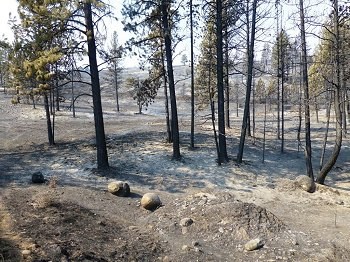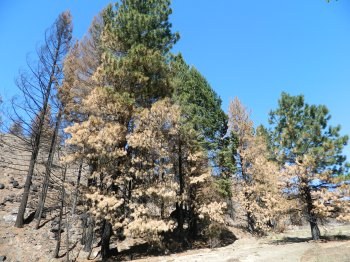Dead Trees Give Life

By Ken Bevis, Washington Department of Natural Resources Stewardship Biologist
from our August 2014 Enews
When forests burn, trees die. It’s a fact. Particularly in hot fires in dense fuels; cambium cooks and needles fry. Conifers are particularly flammable and can go up in spectacular crown fires. The resulting sea of black dead stems causes some people to think we must DO something immediately. Not so fast. Catch your breath.
Post fire recovery is a complicated process that requires time and care to help the forest heal as best as possible. Dead trees have many important roles. They offer some shade to seedlings trying to become established. Roots, although dead, provide soil stability. When they fall, (which can occur immediately, or much, much later), logs on the ground help hold the soil in place, provide decaying organic material and habitat for many species such as chipmunks, small birds and snakes. Small mammals are particularly important to forest recovery for dispersal of colonizing plant seeds and fungal spores that help inoculate soils with important microorganisms. Nutrients are released into the system.
At many levels, dead trees are an integral component of the regenerative process after a fire.
In forests, dead trees are critical habitat for many species, providing nesting and feeding sites for woodpeckers and other cavity dependent species, as perches for song birds, and down logs for ground level habitat. Dead trees are created in pulses over time, single or small groups of trees die in mature forests, killed by fungus, wind, competition between trees, or insects. Or, large numbers of trees are killed all at once, such as in a fire. Some birds, such as the black-backed and three-toed woodpeckers are specifically adapted to utilize fire-killed trees. These dead trees will often stand for many decades and blackened stems can be found in many mature forest stands.

Thick barked trees such as Douglas fir and Ponderosa pine can survive if the fire doesn’t get so hot that it burns the fine roots or kill all of the buds and cambium. These survivors are the scattered trees we see in natural, or thinned and burned, dry forests. Sometimes, trees that appear to be dead at first will recover, and some trees that appear okay will succumb to insects. It is all part of the natural order.
Salvage logging can damage fragile soils and accelerate erosion and weed infestation on disturbed, fragile soils. Removing dead trees that could help stabilize the soil and provide habitat can inhibit forest recovery. Cutting dead trees may be necessary for protection of infrastructure such as buildings or along roads where falling trees could pose safety hazards, or to gather monetary value from trees otherwise destined for harvest. However, dead trees generally do not need to be removed to help the forest recover.
Some manipulations can help recovery. Removing the tops of tall dead trees may help them stand longer by removing some of the weight on the upper stem and introduce heart rot more quickly to soften the stems for woodpeckers. Laying small diameter trees in dense stands across steep slopes can help reduce erosion if the stems are lying completely against the soil. Very dense stands can have extensive down, dead wood making for intense re-burns decades later, so some fuel reduction may be beneficial there. But, overall, the forest recovers best when the dead trees remain, especially the large ones, and nature is allowed to take its course.
Dead trees are beautiful and stark reminders of the fury and healing properties of nature. Ponder their grandeur in the wake of fire and leave them standing as functional landmarks to the power of nature.
For information about Forest Stewardship on private lands, and opportunities for cost-share thinning projects to help protect property from the next event (it’s not if, but when), please visit the Department of Natural Resources Small Forest Landowner Office at www.dnr.wa.gov/sflo. There you will find information on programs and local contacts.
MC note: Ken Bevis & Teri Pieper's house survived the Rising Eagle Fire thanks to the efforts of fire fighters and air attack. Their home is surrounded by burned trees and burned shrub-steppe.